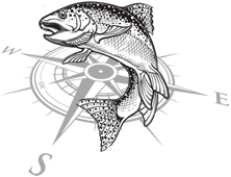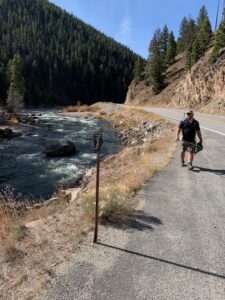
Upper Salmon River in the Fall
America’s first recollection of the Salmon River comes from the journals of Lewis and Clark. At the Continental Divide Lewis split up the Corp of Discovery, sending Clark down the mountain to reconnoiter the Salmon River. Native Americans, namely the Shoshone, had told Lewis of a river that flowed West. Clark, upon discovery of the Salmon River, attempted to float the river but found it unnavigable. Returning to Lewis near modern day Missoula Montana the “Corp” then began their nearly fatal trip across the Bitterroot Mountains in their quest to the Pacific. So began the history of the “River of No Return”.
Today most folks think of the Salmon River as that “River of No Return” a rough, tough dangerous river of deep debts and wide turns. But the Salmon River I’m talking about is where at one point I can actually take one step and I’m across the river. This is the Upper Salmon River. A good geographical starting point would be the town of Stanley or the Sawtooth Mountains. The Sawtooth Mountains is the birth place of the Salmon River drainage. The Salmon River is known as one of the longest freestone river in America. I have come to love the Upper Salmon River and find it one of the best fly fishing rivers in the West.
As a fly fishing river, the Upper Salmon River is one of the most under rated and under fished river in America. You would think that a river that has a good Steelhead, Salmon and incredible Rainbow Trout population would garner some respect. However this lack of recognition bodes well for fly fishermen who know the treasure the Upper Salmon River contains. Nestled between the scenic Sawtooth Mountains and the White Cloud Mountains lies the Upper Salmon River. Highway 75 cuts right through the Valley following the Salmon River on it’s way to Montana. This North/South bi-way attracts tourist and campers from all over America and can swell up the valley’s campgrounds and clog 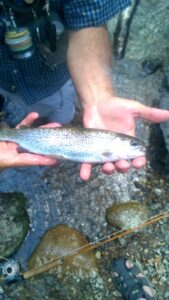 the highway with camp trailers and other RV’s all through the summer.
the highway with camp trailers and other RV’s all through the summer.
This summer migration is not a migration of fly anglers. On the contrary I believe most have no interest in fly fishing. Those who do fish are normally spin fishing and really don’t know the river well enough to be anywhere near successful. This just makes it easier for us fly fishermen who do know the river’s secrets to have great access to the river during the summer months when the river is at it’s best. I do like to be on the Salmon River during the summer when the river, weather and trout make the conditions unbeatable. However the time of year I really prefer to be on the river is in the Fall. The crowds and traffic are gone and the Salmon River is still perfect.
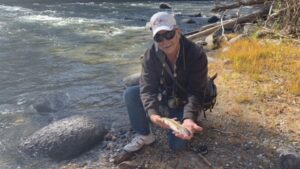
Recently during the Fall my son and I were hoboing around the Upper Salmon River on a fly fishing trip where we found the length of the river all but abandoned of cars and campers. The river was running perfect and clear. Campgrounds along the river were closed or were open but free of charge to camp. The nights were cold and the days hovered around 60 degrees. We had 50 miles of unfished river to play in. I was able to pick and choose with the pickiness of a child in a candy store hanging onto a five dollar bill the most perfect sections of the river to fly fish. I would pull over off the highway, leave the truck running, walk along the road and if I didn’t feel like the section of river before me was perfect I would simply get back into the truck and go down the highway to the next turnout and repeat.
I was looking for either pocket water, long tailouts or compressions caused by the river turning. These were my target conditions. After our second or third stop I saw before me exactly what I was looking for. Before me, the river made a nice turn creating a long tailout that ended into a boulder strew section of pocket water perfect for freestone river fly fishing. I kne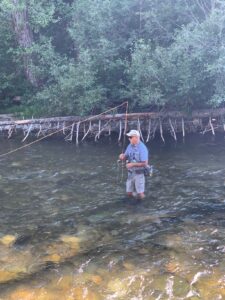 w this run of the river was going to give up some nice trout. I walked upriver on the road until I found a good trail down to the river. I normally work a freestone river from the bottom or a tailout to the top but with a 20 mile an hour wind the exception proved to be the rule. The current of the river turning toward me crashed into a large boulder that created a nice seam and eddy where I know trout love to be. Trying to time the wind so as not to affect my cast too bad I let it rip and my fly landed right at the top of the seam. Bam! an instantaneous explosion on my fly and I had my first trout on my first cast.
w this run of the river was going to give up some nice trout. I walked upriver on the road until I found a good trail down to the river. I normally work a freestone river from the bottom or a tailout to the top but with a 20 mile an hour wind the exception proved to be the rule. The current of the river turning toward me crashed into a large boulder that created a nice seam and eddy where I know trout love to be. Trying to time the wind so as not to affect my cast too bad I let it rip and my fly landed right at the top of the seam. Bam! an instantaneous explosion on my fly and I had my first trout on my first cast.
Ah the curse of the first cast trout. I did manage another trout but not like the size of the first trout. The wind made dry fly fishing tough so before hiking down to the river I grabbed my nymph rod to use if I couldn’t get my dry fly out. After dry fly fishing the tailout I switched to my nymph rod and was able to catch one quite large trout at around 18 inches. So the fishing was going to be tough but I had found a good strategy to choosing the right spot and using both nymph rod and dry fly rod. Both nymphing and dry fly fishing worked well, neither out fishing the other but together working like a machine. When one stopped producing I switched to the other to keep the momentum going.
I found that a size 16 orange and yellow Stimulator and a size16 yellow Humpy were the best combination of dry flies and these flies caught most of the trout at the surface. For nymphing it seemed the trout preferred a green caddis larva fished right on the bottom. When there was a lull in the fishing I knew it was time to move to a new location along the river and start the whole process all over again. My son and I were the only fly fishermen fly fishing the river so really taking our time and looking over a stretch of water became our mission. We turned down more river than we fished and when you are fighting a 20 mile an hour wind and little sun on the water being patient will pay off.
I have been fly fishing the upper Salmon River since I moved to Idaho in the early Nineties. I have never had a time on the river where I did not catch a significant number of trout. I have found that trout who reside in the Salmon River are much larger than trout that live in smaller freestone rivers in the Northwest. Catching Salmon River trout I have found has always been easy if you look for the spots on the river where trout hang out. Find those spots and you will find trout. I have fly fished the same boulder and eddy for years and continue to catch trout there. The more you fly fish the upper Salmon River the more of those boulders you will find. So in many ways I have the home court advantage.
On a river as long as the
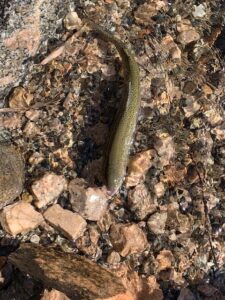
Upper Salmon River where do I begin to fish it and what type of water should I look for? Pocket water is water loaded with boulders that create mini tailwater sections that contain lots of seams and this is where trout live. A tailout is caused by compressed water that is powers through the object that compresses creating a long fast moving tongue. Trout love tailouts too. On the Salmon River this is the type of water you are looking for. The longer the tailout the more trout it will hold. Small pocket tailouts or slicks are great for dry fly fishing because trout that are living there are very opportunistic feeders. Trout have to feed quickly or the food will be lost to the current. Long tailouts are great for the nymph fisherman and the Salmon River is full of those.
Stay away from slow wide moving water. If you are fishing this type of water your odds of catching trout are limited and you will only be burning up time and your legs. Trout do not prefer this type of water in the Upper Salmon River. Other mistakes to avoid is letting your dry fly get wet and sink. On these types of freestone rivers you must keep your dry fly high and dry and on the Upper Salmon River this is the rule. If you see your fly go under the surface then pick it up off the water and make another cast. A good way to keep your fly dry is with dry shake fly floatant and greasing the last ten feet of your fly line and half the length of your leader. A liquid gel floatant like Lochsa by Loon or Loon Payette Paste does the trick well.
There is rarely if ever a need for me to use waders during the Summer and Fall. Of course it’s a good idea to do so if you’re going to be fishing during the Winter. Instead of waders I like to use light weight hiking shoes with a tough sticky black rubber sole. The uppers are nylon that dry fast and the sole clings to rocks like a gecko. If I choose to get my feet wet then at least I know the hiking shoes will dry out quickly. I don’t wear socks. The Upper Salmon River is diverse enough and wide enough to keep wading to a minimal effort at the least.
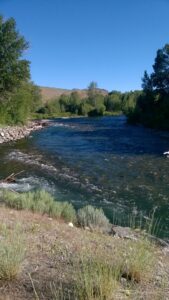
It’s amazing to me how wading a river with waders on makes me do crazy things where if I’m wading wet I tend to be somewhat conservative. I can remember one summer, while fly fishing on the Upper Salmon River for no particular reason other than I had a pair of waders handy, I put them on and waded the river. The Upper Salmon River is not really a difficult river for me to wade but there are stretches where is can be dangerous if you’re not paying attention. I had been fishing up and down the river most of the day and my legs were probably getting a little tired. There was across the river from me a really nice tailout or slick that I knew would hold a couple of nice trout if I could wade out enough to reach it with a dry fly.
It seemed to me to be shallow enough for me to wade out to the middle and then work my way into a good position to make a good cast. Once I got to the middle of the river it became apparent to me that it looks easier to do from shore than it did standing in the middle of the river. The current was strong but I’m a big guy with long legs. My mistake was when I began to move parallel to the current looking for position to make my cast. Moving parallel to the current I began to pick momentum and instead of lifting my foot over a rock I kicked it instead. This brought me head first and arms out right into the river like a beaver entering a river. I was 15 feet down river before I popped up. Fortunately for me I drifted into a shallow sand bar and was able to stand up. I would have never attempted that foolish strategy if I had been wading wet.
The good news was my waist waders didn’t fill up, I still had my hand on my rod and as I stood up and looked around I saw a nice little run on the opposite shore that looked like the perfect spot to hold some trout. Once I recovered enough to cast again I dried my fly off and was able to bring to hand a couple of nice 14 inch rainbows along that slick.. If there is a moral to this story it would be to always error on being conservative in your wading on the Upper Salmon River. You will catch just as many trout standing on a boulder as you would by wading in the river trying to be maneuvering for position. The silver lining is I don’t get as tired standing on shore or standing in water up to my calves as I do wading in full waders waist deep.
Fly fishing the Upper Salmon River in the Fall has many rewards. The Sawtooth Valley is just absolutely gorgeous with the fall colors and the lower water. After a long hot summer the autumn days are cool and the nights are cold but the campfire feels just about the perfect. Sometimes I can’t believe where I am because of the lack of cars and people. The little town of Stanley is still alive and kicking so you can always plan on eating out there to save time cooking. You can walk into a restraint in Stanley during the Fall and walk right to a table. There is an abundance of campgrounds along the river and many are closed for the season but there are quite a few still open and it’s usually free to camp there. Bring your own water and carry out your trash. Most if not all the campgrounds that are open only have a couple of campers in them so you will have no trouble finding a place to hootch out.
The Upper Salmon River is on of the best places I’ve found where the fly fishing is always good and that wilderness experience that we all long for is more than taken care of. Yes Summer on the Upper Salmon River has it’s appeal with the weather and all but it’s during the Fall that I find myself compelled to show up on the river. For me it’s like the final destination for an old fish hobo before the cold of Winter puts us all into hibernation.
Mike Sandifer
Northwest School of Fly Fishing LLC
